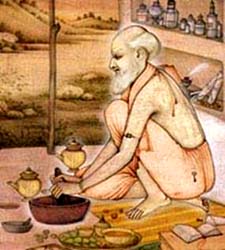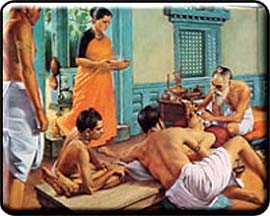Dec 22, 2025
Dec 22, 2025
The Origins - The Myths and Legends
 Indian art of healing is almost as old as the religion of Hinduism itself. Ayurveda attained a state of reverence and is classified as one of the Upa-Vedas - a subsection - attached to the Atharva Veda. The Atharva Veda contains not only the magic spells and the occult sciences but also the Ayurveda that deals with the diseases, injuries, fertility, sanity and health. However, the secrets of life were revealed even in the first Veda, the Rg Veda. The five elements of creation, the Pancha-maha-bhuta, namely the earth, water, fire, air and ether form the basis and essence of all life forms. Out of these arise the three doshas, namely Vata, Pitta and Kahpa. These three doshas unfortunately have been crudely translated as air, bile and phlegm. But the Ayurveda texts, which treat all diseases based on the disequilibrium of these three doshas, are lot more complex. The knowledge consists of three aspects of Ayurveda known as the Tri-Sutras - cause of illness (etiology), symptomatology of disease process and treatment of disease.
Indian art of healing is almost as old as the religion of Hinduism itself. Ayurveda attained a state of reverence and is classified as one of the Upa-Vedas - a subsection - attached to the Atharva Veda. The Atharva Veda contains not only the magic spells and the occult sciences but also the Ayurveda that deals with the diseases, injuries, fertility, sanity and health. However, the secrets of life were revealed even in the first Veda, the Rg Veda. The five elements of creation, the Pancha-maha-bhuta, namely the earth, water, fire, air and ether form the basis and essence of all life forms. Out of these arise the three doshas, namely Vata, Pitta and Kahpa. These three doshas unfortunately have been crudely translated as air, bile and phlegm. But the Ayurveda texts, which treat all diseases based on the disequilibrium of these three doshas, are lot more complex. The knowledge consists of three aspects of Ayurveda known as the Tri-Sutras - cause of illness (etiology), symptomatology of disease process and treatment of disease.
Ayurveda incorporates all forms of lifestyle in therapy. Thus yoga, aroma, meditation, gems, amulets, herbs, diet, astrology, color and surgery etc. are used in a comprehensive manner in treating patients. Treating important and sensitive spots on the body called Marmas is described both in Ayurveda and in Dhanur Veda (another Upa-Veda dealing with martial arts and military science). Massages, exercises and yoga are recommended.
The venerable state of the art of healing was enhanced by the myths and legends of the god of healing, Divodasa Dhanvantari, a patron deity of medicine. The science of medicine was said to have been taught to the sages by Divodasa Dhanvantari, who later wrote them down in the text of Ayurveda. According to another legend, the knowledge of healing originated from the creator Brahma himself, who taught it to Daksha (protector of all beings), who in turn taught it to Indra. When diseases and death became rampant a gathering of the great sages was held in the Himalayas. Sage Bharadvaja volunteered to learn the craft from Indra. He then taught the science to his pupil Atreya, a legendary healer, who then transmitted this knowledge through his disciples. Compilations of this knowledge are called the Ayurveda. Other patron saints of medicine were the twins called Ashvins, who were patrons of eyesight and were physicians that treated the gods themselves.
Atreya held a competition among his six disciples namely Agnivesha, Bhela, Jatukarna, Parashara, Harita, and Ksharapani. Each established a school of his own and taught the traditions of Ayurveda. Agnivesha Samhita was the most
Texts of Ayurveda
Compilations of Atreya and Agnivesha are lost. The knowledge we now have is by three surviving texts of Charaka, Sushruta and Vaghbata. Charaka (1st century A.D.) based his Samhita on Agnivesha Samhita. Sushruta (4th century A.D.) based his Samhita on the Dhanvantari School of Ayurveda. Vaghbata (5th century A.D.) compiled the third set of major texts called Ashtanga Hridaya and Ashtanga Sangraha. The former is more succinct and is based on both Atreya and Dhanvantari schools. Atreya's School of Physicians and Dhanvantari's School of Surgeons became the basis of Ayurveda and helped organize and systematically classify into braches of medicine and surgery.
Sixteen major supplements (Nighantus) were written in the ensuing years - Dhanvantari Bahavaprakasha, Raja and Shaligrama to name a few - that helped refine the practice of Ayurveda. New drugs were added and ineffective ones were discarded. Expansion of application, identification of new illnesses and finding substitute treatments seemed to have been an evolving process. Close to 2000 plants that were used in healing diseases and abating symptoms were identified in these supplements.
Dridhabala in the 4th century revised the Charaka Samhita. The texts of Sushruta Samhita were revised and supplemented by Nagarjuna in the 6th century in a treatise called Upa-hridaya.
There developed eight branches/divisions of Ayurveda:
1. sutra-sthana, general principles
2. nidana-sthana, pathology
3. vimana-sthana, diagnostics
4. sharira-sthana, physiology and anatomy
5. indriya-sthana, prognosis
6. chikitsa-sthana, therapeutics
7. kalpa-sthana, pharmaceutics
8. siddhi-sthana, successful treatment.
Detailed accounts of various methods of diagnosis, study of various stages of symptoms and the comprehensive management of debilitating diseases like diabetes mellitus, tuberculosis, asthma and arthritic conditions are to be found in the Charaka Samhita. There is even a detailed account of fetal development in the mother's womb, which can rival descriptions of modern medical text books. Charaka lists more than 500 remedies in his Samhita.
Charaka also wrote details about building a hospital. A good hospital should be located in a breezy spot free of smoke and objectionable smells and noises. Even the equipment needed including the brooms and brushes are detailed. The personnel should be clean and well behaved. Details about the rooms, cooking area and the privies are given. Conversation, recitations and entertainment of the patient were encouraged and said to aid in healing the ailing patient.
Sushruta Samhita
Sushruta was a surgeon in the Gupta courts in the 4th century A.D. He followed Dhanvantari School of Surgery and is one of the earliest surgeons of recorded history. Though Indian mythology is full of accounts of healing through transplantation of head and limbs as well as eye balls, Sushruta Samhita is the first authentic text to describe methodology of plastic surgery, cosmetic and prosthetic surgery, Cesarean section and setting of compound fractures. Sushruta had in his possession an armamentarium of 125 surgical instruments made of stone, metal and wood. Forceps, scalpels, trocars, catheters, syringes, saws, needles and scissors were all available to the surgeon. Rhinoplasty (plastic surgery of the nose) was first presented to the world medical community by Sushruta in his Samhita, where a detailed method of transposition of a forehead flap to reconstruct a severed nose is given. Severed noses were common form of punishment. Torn ear lobes also were common due to heavy jewelry worn on ear lobes. Sushruta described a method of repair of the torn ear lobes. Fitting of prosthetics for severed limbs were also commonly performed feats.
Sushruta wrote, 'Only the union of medicine and surgery constitutes the complete doctor. The doctor who lacks knowledge of one of these branches is like a bird with only one wing.' While Charaka concentrated on the kaya-chikitsa (internal medicine), Sushruta's work mainly expounded on the Shalya Tantra (surgery).
 The Samhita contains mostly poetry verses but also has some details in prose. 72 different ophthalmic diseases and their treatment are mentioned in great detail. Pterygium, glaucoma and treatment of conjunctivitis were well known to Sushruta. Removal of cataract by a method called couching, wherein the opaque lens is pushed to a side to improve vision was practiced routinely. Techniques of suturing and many varieties of bandaging, puncturing and probing, drainage and extraction are detailed in the manuscript. Sushruta lists more than 700 herbal medicines.
The Samhita contains mostly poetry verses but also has some details in prose. 72 different ophthalmic diseases and their treatment are mentioned in great detail. Pterygium, glaucoma and treatment of conjunctivitis were well known to Sushruta. Removal of cataract by a method called couching, wherein the opaque lens is pushed to a side to improve vision was practiced routinely. Techniques of suturing and many varieties of bandaging, puncturing and probing, drainage and extraction are detailed in the manuscript. Sushruta lists more than 700 herbal medicines.
Ashtanga Hridaya
Vaghbata in the 5th century compiled two sets of texts called Ashtanga Sangraha and Ashtanga Hridaya. The latter of the two combines both the Atreya and Dhanvantari schools. It details the Kaya-chikitsa of Charaka Samhita and the various surgical procedures of Sushruta Samhita. Exhaustive descriptions of kapha, vayu and pitta are given. However, the emphasis seems to be more on the physiological rather than the spiritual aspects of the disease processes. Ashtanga Hridaya is written in prose whereas the Ashtanga Sangraha is in poetry form.
The Ancient Indian Physician
Originally only Brahmins were practicing physicians. Later people from other castes became well versed in the art of healing and a term Vaidya came to be applied to the practitioners. Merely by their art and knowledge, the physicians gained high social status regardless of their caste of birth. The court physician was of political importance and sat on the right side of the throne, an important symbolic place. Though the physician, patient, the nurse and the medicine were all important in curing a disease, the physician was thought to be the most important.
The codes of conduct for physicians and medical students were laid down by the texts of Laws of Manu. The poor and downtrodden were to be treated free of charge. Others were charged according to their ability to pay.
The physician was expected to behave in an exemplary manner, conforming to the highest ideals of professional and personal life. His dress, manner and speech were expected to be beyond reproach. Medical education was arduous, consisting of many years of sacrifice learning the art of healing. Visiting the sick, collecting herbs and preparation of drugs, memorizing the Vedic texts of Ayurveda, performing procedures on dead animals, melons, and leather bottles and bladders were part of the training. These exercises helped refine both theoretical and practical training of the student. When finally the student is deemed ready to practice on his own, he is certified by the ruler. The system closely resembles that of the Hippocratic Oath of Greece.
How much influence Greece had on Indian medicine is hard to say. We know that astrology and astronomy were both greatly influenced by the Greeks (solar calendar, for example). Most of the texts available to us were written after the Greeks made their appearance (Alexander in 3rd century B.C.) and stayed in the Northwest India for several decades. How much the Indian physician learned from the Greek counterpart and vice versa is a question not answered.
References:
1. Albert S. Lyons MD and R. Joseph Petruccelli MD; Medicine: An Illustrated History
2. D.P. Agrawal; Sushruta: The Great Surgeon of Yore
3. Parveen Chopra; Ayurveda: A Healthy Revival
4. P.V. Sarma: History of Medicine in India
5. Sankaran P. S. and P.J. Deshpande; Sushruta
6. Internet Sources
Disclaimer:
Information provided in this article is for the sole purpose of imparting education on Ayurveda and is not intended to diagnose, treat, cure or prevent any disease. If you have a medical condition, please consult your physician.
11-Apr-2004
More by : Dr. Neria H. Hebbar

|
A wonderful post. Read Sushruta in my school days. It is unbelievable that such a genius was born in this country! |